|
 
Authorized
Agent

partner
links
| |
|
Home Espresso
Machine Buyers Checklist
Helpful tips on buying
the right espresso machine from Marty Howard, founder of
Espressoworkz.
Over the years we�ve helped thousands of Kiwi�s choose the
Espresso machine that�s right for them.
Based on our experience, these are the key issues
you need to think about when deciding what machine
is going to work best for you. |
|
|
Why are you
really buying an espresso machine?
Here are
some rules of thumb:
-
Are you buying it
just to make a couple of sumptuous Saturday morning brews and you're
on a tight budget or only have a very small space for it?
You need
a small manual group handle espresso machine: Total Spend $350 -$900
plus grinder (optional)
|

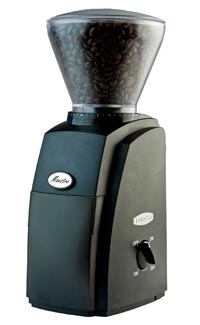 |
-
Is your primary driver
to perfect the ultimate coffee experience?
-
Do you
want a piece of culinary artwork that sits on your kitchen bench in
all of its stainless steel glory and is seldom used? - (that's ok by
the way)
You need
a semi commercial machine with gauges, commercial group handle, non
pressurised group basket, metal tamper, and a small conical grinder:
Total Spend $2500 - $3,500
|
 |
-
Do you
want to produce impressive cappuccinos for dinner party guests without being away from the
table for more that five minutes?
-
Do you have a busy lifestyle, enjoy dining out regularly,
and want consistent coffee with the minimum of fuss?
You need
a fully automatic machine, with a built in grinder and milk frother.
Total Spend $1,000 - 2,500
|
 |
|
How
much should you spend?
You can spend from $40 upwards on a
espresso machine, but generally if you want a machine that will continue
to make good coffee and
last for more than a couple of years, like anything, you have to pay for
it. In our experience a basic, decent machine will cost at least
$350 upwards.
|
|
|
What type: Steam,
Piston, Pod, Grinders Manual Pump Traditional Machine or Super Automatic?
- decisions! decisions!
Steam
You can buy steam models for $100 to $200. They may froth
your milk, but the coffee won't be anything to write home about - It's
likely to taste a little bitter. .
You can also try stove-top espresso jugs costing as little as
$40 but, again, the coffee may be bitter and it won't be great.
Several types of machine claim to make espresso-based
coffee, but only one really delivers � one with a pump in it. Machines
with pumps operate at higher pressure than steam machines and employ a
thermostat to control the water temperature. The pump both makes the
coffee and froths the milk.
|
 |
|
Piston
This is an elegant old world espresso machine - a throw
back to a time when espresso was first discovered.
These machines are best suited for people that thoroughly
enjoy the ritual of making espresso, a hobbyist or other coffee culture
enthusiast. The ease of use is low and the learning curve is high.
However the coffee that they are capable of extracting is on par with
the best machines.
Some have nice frothers, powerful enough for home use. You
will have no problem making a couple of cappuccino's, however since they
do not have a water reservoir you will find that they are not that
practical for large gatherings. Other than that they are an exceptional
showpiece!
To use. pull down on the machine's handle to force the
hot water through the coffee. This does require some arm strength and
the consistency of the pull is critical to obtaining a good extraction
or espresso.
|
 |
|
Manual or
automatic?
Automatic espresso machines have one big advantage over manual models -
convenience. You simply pour the coffee beans into the hopper, fill the
tank with water, press the coffee button, and ... hey presto ...
espresso!
It�s a
bit like a car, a manual car gives better fuel efficiency and
power if you drive it right, racing cars are manual...but most people in the end prefer an automatic
because it's just easier.
An
automatic machine is likely to have many more features than a manual
one, such as digital display panels, indicators, variable strength
settings, and so on.
If
perfect caf� quality espresso is more important to you than convenience,
a manual model is probably a better bet. Remember, you'll have to grind
the beans separately. You can buy ground beans, or use your own grinder.
|
|
|
Manual Pump Traditional Machines
With these machines the user starts the pump with an on/off
switch and you stop the pump when the extraction is complete. The
extraction takes about 20 to 25 seconds so the user will wait for the
coffee process to finish and then switch off the pump. Some machines can
be set to turn the pump off automatically by using a timer.
Most machines use a boiler and they also have a separate
water reservoir, so they can make several cups before refilling the
water tank. The boilers will all have some overheating protection device
- like a thermal fuse - to protect the machine as well as the user.
There are newer generation heating devices that use a thermoblock or
thermocoil system instead of a boiler. The water is heated on demand as
it passes through a heating tube, which makes for faster heating to brew
temperature. Not to confuse you, but there is even a hybrid thermoblock/boiler
version available. Unless you have a preference, consider the total
machine capabilities - not boiler style.
Frothing on these machines varies from simple to
highly skilled . The machines with frothing adapters help in the aeration
process, however those with more traditional steaming wands are easy to
master once you know the technique. Most of the machines will
steam at least 400mls of milk, which is far more than you will
normally need. Range of motion on the steam wand is also a consideration
for some. However all the machines we sell are capable of using a 600ml
steaming pitcher. Anything larger is not recommended, the height of the
steaming pitcher starts to become an issue because it will inhibit your
range of motion. Also, if you wish to steam half a cup milk the
low level will make it more difficult to reach with the steam wand.
Frothing and nearly all other commentary on the semi
automatics can be applied to the fully-automatics; see those comments
above.
With these
machines you will need to regularly buy freshly espresso fine ground
coffee, or buy a grinder.
|

 |
|
Grinders
The two
main types of acceptable grinder are the flat burr type and the conical
type. The burr grinder is the most common and is fine for most home
situations. The conical grinder is often more expensive because it has a
better grinding system. Its' motor spins slower so generates less heat, so
there is less chance of the coffee being burnt during the grinding
process. It generates a grind particle size that is more consistent than
the grind particle of the flat burr grinder, but is more expensive.
Total Spend: $100 -$700
You
can also get blade grinders . They have a blade similar to that of a propeller that
chops the coffee beans. The fineness of the grind is determined by how
long you let the grinder operate via a built in timer. The longer it grinds the finer the coffee becomes.
The negatives of a blade grinder are that the grind can
vary from powder to chunks and the coffee picks up a static charge, which
will make it stick to just about everything and is therefore very
messy. For these reasons, we do not recommend blade grinders.
built in timer. The longer it grinds the finer the coffee becomes.
The negatives of a blade grinder are that the grind can
vary from powder to chunks and the coffee picks up a static charge, which
will make it stick to just about everything and is therefore very
messy. For these reasons, we do not recommend blade grinders.
|

 |
|
Capsule Machines
These are nice and clean as there are no grinders or grinds involved,
and the machines are often not very expensive. One of the important
aspects of a capsule system is the technology behind its capsules. For
expamle with the Caffitaly System the core of the technology is the use
of two small filters inside the capsules. Water is forced with pressure
through the first filter allowing an even contact with the tightly
packed 8 grams (or 0.28 ounces) of coffee grains. When it passes through
the second filter, the coffee is extracted and exits as a full-bodied,
dense espresso, blanked with a consistent, compact cream.
The downside is that the
capsules are imported, as
opposed to being freshly roasted and ground locally, like a loaf of
freshly baked bread. It's also a bit like buying an inkjet printer, you
save on the machine but they get you on the consumables, a coffee shot
made from a pod will typically be double the cost of one made from New Zealand freshly roasted coffee beans!!
|
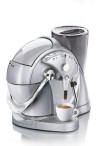
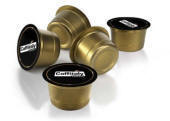
|
|
Super Automatics
These machines are simply that - super automatics. They
perform the entire ritual for the user in a fraction of the time. They
contain water reservoirs and integrated coffee grinders. This is push
button technology at it's best. Press the brew button and it will grind
the right amount of beans, tamp the ground beans, extract a
predetermined amount of coffee and then it will dispose of the puck
(left over coffee) into an internal dump box. Some models will even help
the user maintain the machine. The popularity of this style of machine
is the fastest growing in the market. This machine presents some
substantial advantages to all others that we have discussed.
Special features found on the super-automatics
can be really cool and add considerable flexibility. Some will give you
the ability to change the coffee strength by controlling the amount of
coffee used in each extraction. This can be used to make weaker or
stronger espresso, doubles and long blacks. You can make these on demand with freshly ground
beans - a cup of coffee doesn't get any easier than this!
Some machines will even provide a bypass doser. This feature
allows the user to bypass the whole bean coffee grinder with pre-ground
coffee. The most common use is decaf for those guests that can't drink
the good stuff or perhaps you don't feel like caffeinating yourself in
the evening. This prevents the desire to dump the beans out of the
hopper and gives more practical value to the machine for some buyers.
The coffee quality offered by these machines is excellent and usually
exceeds that produced by most home users on their manual machines.
This is not to say that you can not make it better yourself,
it is just very unlikely that the average user has the knowledge or
skill to make a better product. This is particularly true in regards to
consistency - the ability to make a great extraction one after another.
I speak from substantial experience with all varieties of users.
Frothing is very simple. They all have frothing adapters
which as described earlier, help in the aeration of the milk to
produce a thick froth. Some also have automatic milk frothers, where the
milk is sucked from a milk jug and foamed directly into you cup. They are unique in that they do not use boilers
for heating of the water for brewing or steaming. They use a thermoblock
technology that heats the water as it passes through a tube encased in
an aluminum block - hence the name thermoblock! They react very quickly
and are capable of steaming continuously. The pump goes into a slow
pulsing action that sends droplets of water from the reservoir into the
superheated thermoblock where it is flashed steamed. This is a very
effective system that also works well for hot water dispensing.
Maintenance and cleaning of the Super Automatics is on the
lowest end of the scale for comparison purposes. These are no-tools
required systems - some are self -cleaning and for those of you who want
to visually inspect the brewing components you can remove the entire
brew group on some models.
The Super Automatics will go further than simply making an
espresso automatically. They take the used grounds and place them into
an internal dump box, when this is full the machine will tell you. The
machine will also indicate when it is out of water. Some models have
their own cleaning cycles, decalcification cycles and auto-rinse cycles.
A concern for some users is that the super-automatics take
away the control that you get with the other styles. This is true to an
extent. One concern some have is that you cannot control the
tamp pressure. This is also true, but what you want is consistency of
tamp pressure. Therefore, you should change the fineness of the grind to
suite the tamp.
As you would expect, all the grinders have a wide range of
settings. In fact they all use very strong conical burr grinders with
gear reduction systems. This makes the grinder a real strength.
|
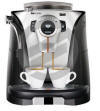
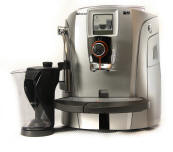




|
|
Let's face it- size does matter!
Its likely your going to want to put the machine on your
bench, and if you buy an attractive looking machine it can be a lovely
feature in your kitchen, so looks are important. Also, whether out on
display or installed inside a servery kitchen cupboard�it still has to
fit. Measure the space you have available before you go shopping.
|
|
|
Single Verses Double
Heating Elements?
If the machine has only one boiler or heating element you
will have a wait time between making coffee and making steam for the
milk of between 20 � 50 seconds depending on the machine. This can seem
like a lifetime when you're waiting! The inclusion
of a second boiler or chamber for heating steam practically eliminates
this wait, making it possible to produce cappuccinos and lattes in a
snap and also get rid of the necessity to cool the boiler (letting
excess steam and water out of the steam wand) after steaming.
|
|
|
What
Make or Brand should I Choose?
The best coffee machine brands come from in and around Italy, so its likely you
wont be familiar with some of the manufacturers names.
Espresso machines do break down. Its advisable
to buy from a reputable dealer and check the warranty on the machine.
Ask about their experience with the brand's service department, turn
around times and spare parts holdings. One of the great things about
goods being mass produced in China is you can buy them at a cheap price,
the bad side is if they break down outside of the warranty period; they
aren�t worth fixing, so when they break down out of warranty, they're
destined for the wheelie bin. The old adage stands true - What you pay
for is what you get!
So if you
buy a cheap espresso machine, be prepared to replace it in a short
period of time.
|
|
|
Will I be able to make
good coffee when I get it home?
The key to making great espresso coffee
other than good quality clean machinery, is using good ingredients
(fresh quality coffee beans), and following the right process to make
the drink style you desire. The best Australasian publication I have
come across that explains clearly all about how to make great espresso
coffee in the home is the recently published "The Home Coffee Machine
Review" magazine.
|
|
| |
|
To order your own copy on
line now click here....... |
|
| |
|
| |
|
| |
|
| |
|
| |
|
| |
|
| |
|
| |
|
|
|
| |
|
|